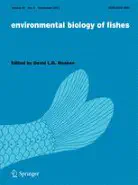Structure, growth and production of a remarkably abundant population of the common goby, Pomatoschistus microps (Actinopterygii: Gobiidae)

Abstract
The common goby, Pomatoschistus microps, is a relevant species from estuarine food webs, playing important roles as predator of polychaetes and crustaceans and as prey for larger fishes and crustaceans. The Minho estuary (NW Portugal) is a relatively well preserved and productive system. To assess the population structure and production of P. microps in this estuary, monthly samples were undertaken in three different areas along an estuarine gradient in the lower estuary. The density of P. microps varied considerably among seasons and sampling stations, with higher densities occurring in summer and autumn. The lowest densities were found closer to the sea. In general, the density of females was higher than the density of males in all sampling stations, while juveniles were more abundant within a salt marsh area. Compared with other European estuaries, our data showed a remarkable higher density and production values of P. microps. This may be related to the high freshwater input and the low salinities found in this estuary. In addition, we hypothesize that the lower density of the sympatric species P. minutus and the high availability of bivalve shells observed in the Minho estuary may have also contributed to the present results, once P. minutus and P. microps often display a diet overlap and the bivalve shells are crucial for the common goby reproduction.